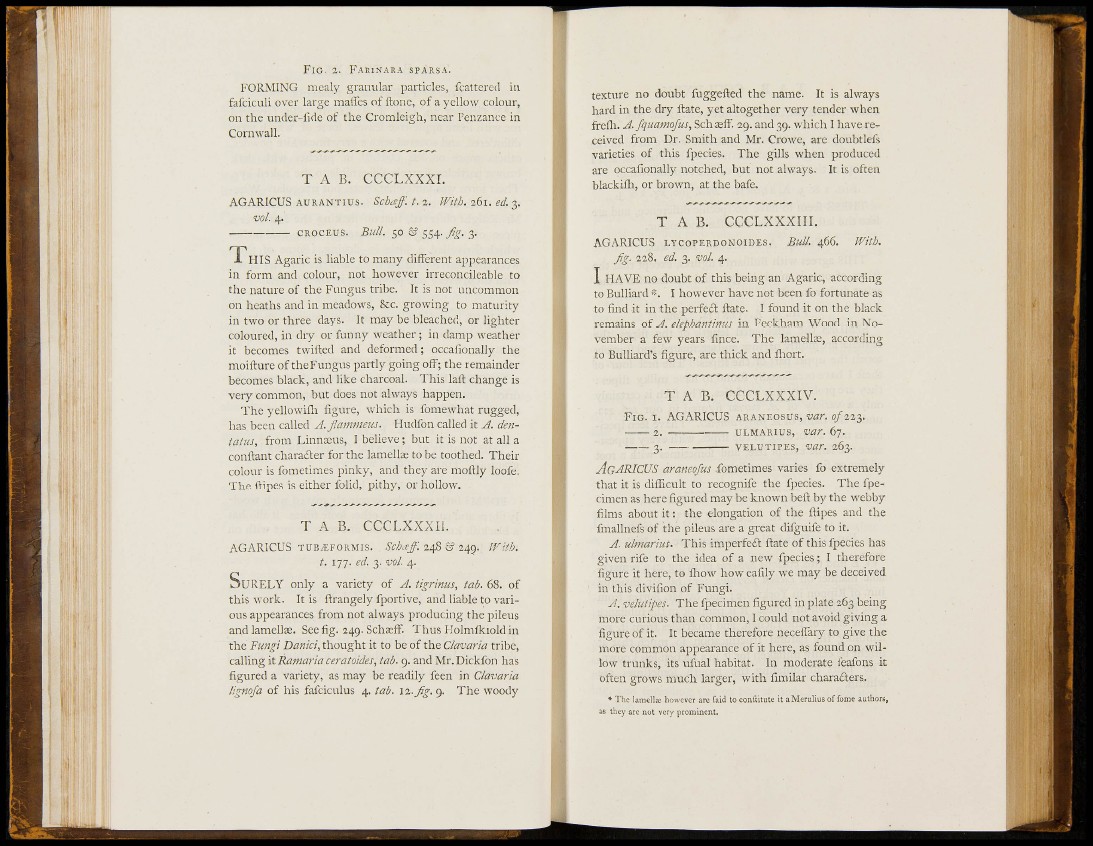
£ i
FIG. 2. FAHINARA SPARSA.
FORMING mealy granular particles, fcattered in
fafciculi over large maires of ftone, of a yel low colour,
on the under-fide of the Cromleigh, near Penzance in
Cornwall.
T A B . CCCLXXXI.
AGARICUS AURANTIUS. Scbaiff: t. 2. With. 261. ed. 3.
vol. 4.
cRocEus. Bull. 50 S" 5 5 4 - 3 .
T H I S Agaric is liable to many different appearances
in form and colour, not however irreconcileable to
the nature of the Fungus tribe. It is not uncommon
on heaths and in meadows, Sic. growing to maturity
in two or three days. It may be bleached, or lighter
coloured, in dry or funny weather ; in damp weather
it becomes twifted and deformed; occafionally the
moifture of theiXingus partly going off; the remainder
becomes black, and like charcoal. This laft change is
very common, but does not always happen.
The yellowifli figure, which is fomewhat rugged,
has been called A. Jlammeus. Hudfon called it A. dentatus,
from LinnKus, I bel ieve; but it is not at all a
conftant charaaer for the lamelte to be toothed. Their
colour is fometimes pinky, and they are moftly loofe.
The ifipes is either folid, pithy, or hollow.
T A B . CCCLXXXli.
AGARICUS TUB^FORMIS. Scbit;]}: 248 S 249. IViib.
t. \Tj. ed. 3. vol 4.
S U R E L Y only a variety of A. tigrinus, tab. 68. of
this work. It is ftrangely fportive, and liable to various
appearances from not always producing the pileus
andlamelte. See fig. 249. Scha;ff. Thus Holmfkioldin
the Fungi Danici, thought it to be of the Clavaria tribe,
calling ilRamariaceratoides, tab. 9. and Mr.Dickfon has
figured a variety, as may be readily feen in Clavaria
lignofa of his fafciculus 4. tab. 12. Jig. 9. The woody
texture no doubt fuggefted the name. It is always
hard in the dry ilate, yet altogether very tender when
frefli. A. fquamofus, Schajff. 29. and 39. which I have received
from Dr. Smith and Mr. Crowe, are doubtlefs
varieties of this fpecies. The gills when produced
are occafionally notched, but not always. It is often
blackifli, or brown, at the bafe.
T A B . CCCLXXXIII.
AGARICUS LYCOPERDONOIDES. Bull. 466. With,
fig. 228. ed. 3. vol. 4.
Ì HAVE no doubt of this being an Agaric, according
to Bulliaixl I however have not been fo fortunate as
to find it in the perfeit ftate. I found it on the black
remains of A. ekpbantinus in Peckham Wood in November
a few years fince. The lamellae, according
to Bulliard's figure, are thick and fliort.
T A B . CCCLXXXIV.
FIG. I. AGARICUS ARANEOSUS, var. 0/223.
1. uLMARius, var. 67.
3. VE L U T I P E S , var. 263.
AGARXCUS araneofus fometimes varies fo extremely
that it is difficult to recognife the fpecies. The fpecimen
as here figured may be known beft by the webby
films about it: the elongation of the ftipes and the
fmalhiefs of the pileus are a great difguife to it.
A. ulmarius. This imperfe£l ftate of this fpecies has
given rife to the idea of a new fpecies; I therefore
figure it here, to fhow how eafily we may be deceived
in this divifion of Fungi.
A. velutipes. The fpecimen figured in plate 263 being
more curious than common, I could not avoid giving a
figure of it. It became therefore neceffarj^ to give the
more common appearance of it here, as found on willow
trunks, its ufual habitat. In moderate feafons it
often grows mitch larger, with fimilar charaaers.
* The lamella: however are faid to conftitute it aMerul ius of fome authors,
iis they arc not very prominent.
li- ' '